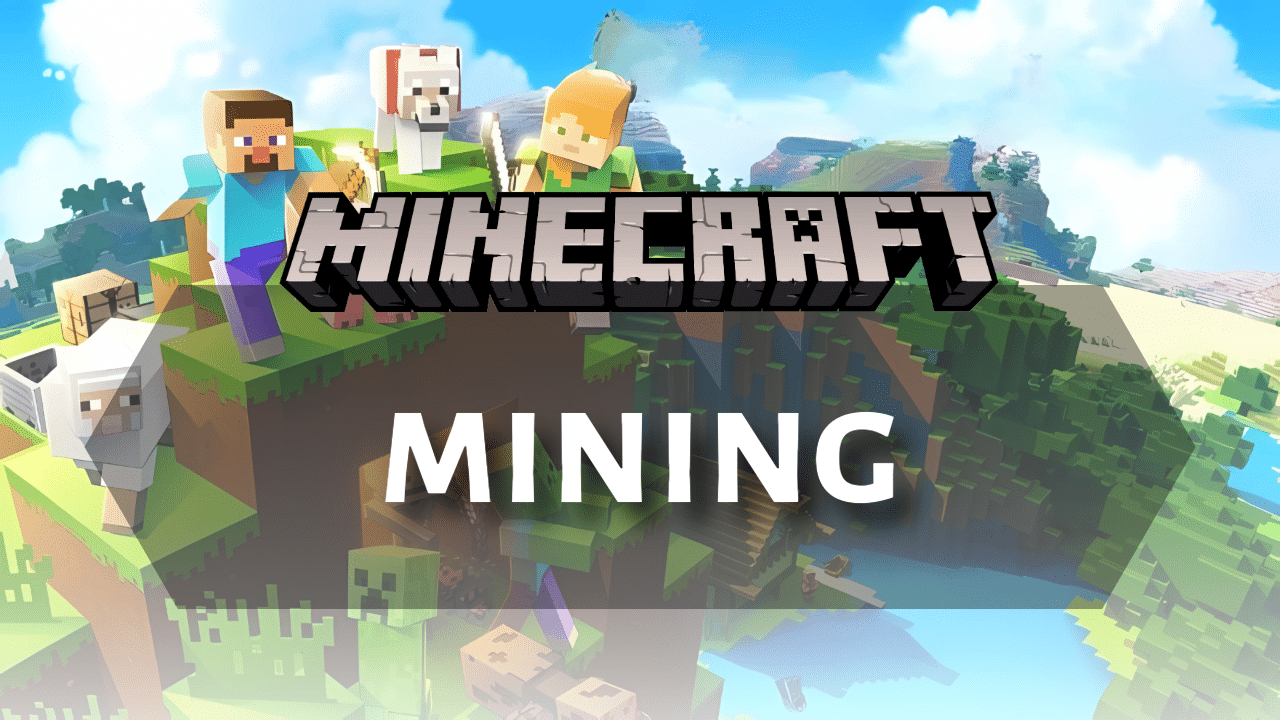
Introduction
Hello there, future master miner! Welcome to the Minecraft Bedrock Mining Guide, your ultimate resource for mastering the art of mining in Minecraft Bedrock Edition. Digging down can lead to incredible treasures, and mining is like being a super explorer—uncovering shiny ores and useful stones that help you build amazing creations, craft powerful tools, and protect yourself from monsters. This guide will teach you everything you need to know to become a mining expert in no time. So grab your pickaxe, and let’s get digging!
Getting Ready for Your Big Mining Adventure
Before you head down into the dark, it’s super important to be prepared, just like a superhero getting their gear ready. Think of your tools as your best friends underground.
Pickaxe
First, you’ll need a pickaxe. This is your main tool for breaking rocks and ores. There are different types of pickaxes, starting from wooden (which breaks easily), then stone, iron, gold, diamond, and the super strong netherite.
You can make a pickaxe using a crafting table with two sticks and three blocks of the material you want. Remember, stronger pickaxes can mine better ores and last longer. For example, you’ll need at least an iron pickaxe to mine shiny diamonds. It’s a good idea to bring a few pickaxes with you, especially on longer trips. Sometimes it’s even smart to keep your old wooden pickaxe and use it until it breaks before switching to a stone one, especially if you suddenly find some iron or copper.
Shovel
Next, a shovel is handy for quickly digging through dirt and gravel. Sometimes, annoying gravel can fall on you, so a shovel will help you get out quickly.
Torches
Don’t forget torches! It’s super dark underground, and torches will light your way so you can see where you’re going, find ores, and stop scary monsters from appearing. Always bring a big stack of them.
Water Bucket
Water buckets are lifesavers! If you accidentally run into hot lava, you can pour water on it to make it safe obsidian. You can even make a never-ending water source by digging a small hole and pouring water in. In the Nether, though, water won’t work, so a fire resistance potion is a great idea to protect you from lava.
Iron Sword
For protection, bring a sword or a bow and arrows to fight off any monsters you might meet. Wearing armor made of leather, iron, diamond, or netherite will also help you stay safe. A shield is also super useful for blocking attacks from skeletons and creepers.
Chest
Sometimes your inventory will get full of all the cool stuff you find, so if you can, bring a chest or even better, a shulker box to store extra goodies. Remember, you can only break an ender chest with a pickaxe enchanted with silk touch.
Coordinates
To help you find your way back to the surface or your mining base, pay attention to your coordinates. In Bedrock Edition, you can turn them on in your game settings. The middle number is your Y-level, which tells you how high or deep you are. You can also leave markers like torches or special blocks to remember the path you’ve taken.
Most importantly, remember the first rule of Minecraft: never dig straight down! You could fall into a deep cave or even a pool of lava.
Your Best Friend: The Pickaxe and its Magic Powers
Enchantments
Your pickaxe is the most important tool for mining, and upgrading it with enchantments can make it even better. Using an enchantment table, you can give your pickaxe special abilities.
With these enchantments, your pickaxe will be even more powerful and useful for mining deep underground.
Different Ways to Become a Mining Master
There are lots of different ways to explore and find resources underground. Here are a few popular methods:
Cave Mining
This is like exploring natural tunnels and rooms that are already in the ground. Look for openings in hills or mountains and venture inside. Remember to place torches often so you don’t get lost and to stop monsters from appearing. If you find a monster spawner (a block that makes monsters), try to light it up quickly with torches to stop the monsters.
Cave mining is great in the early game because you can quickly find iron and other ores to craft tools and armor. Large cave systems often have lots of ore, making this method one of the most efficient ways to mine. It also saves pickaxe durability since you don’t have to dig through stone. Underwater caves are an especially good place to find diamonds, as they generate more frequently there.
However, cave mining has its risks. Unlit caves are full of monsters, so torches and weapons are a must. Large caves can be confusing, making it easy to get lost. Falling into deep holes or lava pools is another danger. Additionally, exposed ores sometimes don’t generate due to Minecraft’s ore distribution rules, making mining in large caves slightly less rewarding.
Shaft Mining
Shaft mining in Minecraft Bedrock Edition involves digging vertical or diagonal tunnels to access underground resources efficiently. A simple mineshaft can be a 1×3 or 4×4 structure with ladders for safe traversal, while staircase mines provide an alternative without requiring ladders. Vertical shafts, such as 1×1 or 2×2 tunnels, allow players to reach deeper layers quickly, but precautions like water drops or ladders are necessary to avoid fall damage.
Players often use branch mining from a central shaft, extending tunnels at Y-levels optimal for ores like diamonds (-58) or iron (16). To maximize efficiency, spacing tunnels two to three blocks apart ensures exposure to ore veins while minimizing redundant mining. In natural mineshafts, players can collect wood, rails, and loot while dealing with hazards like cave spiders. For optimal mining safety and efficiency, lighting tunnels with torches and maintaining organized pathways can prevent getting lost and ensure a steady resource supply.
However, cave mining has its risks. Unlit caves are full of monsters, so torches and weapons are a must. Large caves can be confusing, making it easy to get lost. Falling into deep holes or lava pools is another danger. Additionally, exposed ores sometimes don’t generate due to Minecraft’s ore distribution rules, making mining in large caves slightly less rewarding.
Branch Mining
Branch mining is a great way to find ores while using your pickaxe efficiently. Start by digging a main tunnel at a good depth, such as Y-level -57 for diamonds. From this main tunnel, dig side tunnels (or “branches”) every few blocks.
This method helps expose ores while reducing the number of blocks you need to mine. Spacing the tunnels about three blocks apart is a good balance between thoroughness and efficiency. This method is great for gathering large amounts of iron, diamonds, and redstone.
Strip Mining
Strip mining in Minecraft Bedrock Edition involves digging long tunnels at optimal Y-levels to efficiently uncover ores and resources. The standard method consists of creating a central tunnel with evenly spaced branch tunnels, typically two to three blocks apart, to maximize ore exposure while minimizing effort.
This method is particularly effective for mining diamonds at Y-57, iron in mountain biomes at Y-232, and gold in the Badlands between Y-32 and Y-256. A variation called crawl mining uses 1×1 tunnels, achieved with trapdoors, which increases the number of new blocks revealed per mined block, making it highly efficient in deepslate areas. Strip mining is also an excellent way to collect coal at Y-136 and redstone at Y-57, especially since caves are less common at these levels.
To ensure safety, carrying a water bucket helps counter lava flows, and placing torches every 13 blocks prevents hostile mobs from spawning. By choosing the right Y-level and technique, strip mining remains a sustainable and effective mining strategy for long-term resource gathering.
Quarry Mining
Quarry mining involves digging a large, square or rectangular pit straight down, layer by layer. This method exposes every block in an area, ensuring all resources are collected.
A quarry can be useful for getting massive amounts of stone, iron, and coal, but it takes a lot of time and effort. Be careful of falling and make sure to light up your quarry to prevent monsters from spawning.
Deep Dark Biome Mining
Deep Dark mining in Minecraft Bedrock Edition is an advanced technique that involves mining sculk blocks to uncover hidden ores while gaining experience points. This method is similar to moss mining, where breaking one type of block exposes others beneath it. To begin, players must locate the Deep Dark biome and carefully clear skulk shriekers to prevent summoning the Warden.
Shriekers can be disabled by surrounding them with wool blocks or broken outright using a tool. Once the area is secure, a stone or better hoe allows for rapid, near-instant mining of sculk blocks, revealing potential ores like lapis lazuli that might have been hidden due to air exposure rules. Unlike other caves, the Deep Dark does not naturally spawn regular hostile mobs, providing a uniquely peaceful mining environment. However, the biggest risk is accidentally triggering a shrieker too many times, which can summon the Warden, a nearly indestructible entity with powerful attacks, including a sonic blast that can hit through walls.
To mitigate this risk, players should set a spawn point nearby and have an escape route planned in case they need to flee. Despite the dangers, Deep Dark mining can be highly rewarding, offering both valuable ores and significant experience gains. Whether or not to mine here depends on a player’s willingness to face the risks for the potential rewards hidden within the sculk-covered depths.
Finding All the Shiny Things: Ores and Where to Look
Different ores like to hang out at different depths, so knowing your Y-level is key.
Coal
Coal is one of the most abundant and essential resources in Minecraft Bedrock Edition. It generates between Y-levels 0 and 256, but is most commonly found in exposed cliffside veins, hills, and caves at Y-levels 95 to 136.
Coal ore drops coal when mined with any pickaxe and is primarily used as a fuel source in furnaces. It can smelt eight items per piece, making it an efficient early-game energy source. Blocks of coal, crafted from nine pieces, provide an even longer burn time. Villagers, particularly novice-level armorer, toolsmith, and weaponsmith villagers, buy coal in exchange for emeralds.
Iron
Iron is a crucial early-to-mid-game resource used to craft armor, tools, and essential utility blocks such as anvils, hoppers, and blast furnaces. It generates widely but is most common around Y-level 16 and in high mountain peaks at Y-level 232.
Mining iron ore drops raw iron unless mined with a Silk Touch pickaxe. Smelting raw iron in a furnace or blast furnace yields iron ingots. Fortune enchantments increase the number of raw iron drops, making it more efficient to mine iron-rich veins.
Copper
Copper is primarily found at Y-level 48 and is more concentrated in dripstone caves. It generates in large ore veins and drops raw copper when mined.
Smelting raw copper produces copper ingots, which are used for crafting spyglasses, lightning rods, and decorative copper blocks that oxidize over time unless waxed with honeycomb. Copper ore is affected by the Fortune enchantment, increasing the number of raw copper drops when mined.
Gold
Gold is a valuable but less common resource that appears more frequently at Y-level -16 , especially in Badlands biomes, where it generates in higher quantities and at higher elevations. Mining gold ore yields raw gold, which can be smelted into gold ingots.
Gold tools and armor are weaker than iron but have faster mining speeds. Piglins in the Nether trade valuable items when given gold ingots, making it a crucial material for bartering. Gold is also used to craft golden apples, powered rails, and clocks.
Redstone
Redstone is commonly found deep underground around Y-levels -57 and -58. Mining redstone ore drops redstone dust, which is essential for building automated contraptions, powered rail systems, and complex redstone mechanisms.
Redstone blocks, crafted from nine redstone dust, serve as compact storage or as a power source for redstone devices. Fortune enchantments increase redstone drops, making it easier to accumulate large amounts.
Lapis Lazuli
Lapis Lazuli generates mainly at Y-level 0 and is a crucial resource for enchanting. Mining lapis lazuli ore yields lapis lazuli, used primarily to enchant tools, weapons, and armor at an enchantment table.
It is also used for crafting blue dye. Since Fortune increases lapis lazuli drops significantly, using an enchanted pickaxe maximizes collection efficiency.
Emerald
Emeralds are the rarest overworld ore and only generate in mountain biomes, with the highest concentration at Y-level 236.
They are primarily used as currency for trading with villagers, making them highly valuable for acquiring enchanted gear, rare blocks, and food. Mining emerald ore drops a single emerald unless a Fortune-enchanted pickaxe is used. Unlike other ores, emeralds do not generate in large veins.
Diamond
Diamonds are one of the most sought-after resources in Minecraft, found mainly at Y-level -58.
Diamond ore drops diamonds when mined with an iron or better pickaxe. Diamonds are used for crafting the most durable tools, weapons, and armor in the game, as well as high-tier utility blocks like enchantment tables and jukeboxes. Fortune significantly increases diamond yields, making it beneficial to use an enchanted pickaxe when mining.
Ancient Debris
Ancient Debris is an extremely rare Nether-exclusive resource found aroundY-level 15.
It does not burn in lava and is used to craft Netherite, the most durable material for tools and armor. Mining ancient debris requires a diamond or Netherite pickaxe, yielding ancient debris blocks that must be smelted into Netherite scraps.
To see your current Y-level in Bedrock Edition, open the game settings, go to the Game section, and turn on Show Coordinates. Once activated, your coordinates will appear in the top left of your screen, helping you track your depth for the best mining spots.
Tips for Mining
Conclusion
Now you’re ready to head underground and discover the amazing world of Minecraft mining in Bedrock Edition! Remember to be prepared, stay safe, and have fun finding all those precious resources.
If you’re looking for more guides, be sure to explore the website for more tips and tricks. Enjoy your adventure, and happy mining!
Frequently Asked Questions(FAQs)
How do I avoid lava when mining?
Lava lakes are most common around Y-level -54. Stay one or two blocks above this level (like -53 to -55), mine carefully, and always carry a water bucket to turn lava into obsidian or create escape paths.
How do I safely mine near gravel or sand?
Gravel and sand are affected by gravity. Use a torch trick: break the bottom block and quickly place a torch and falling blocks will break on contact with the torch.













